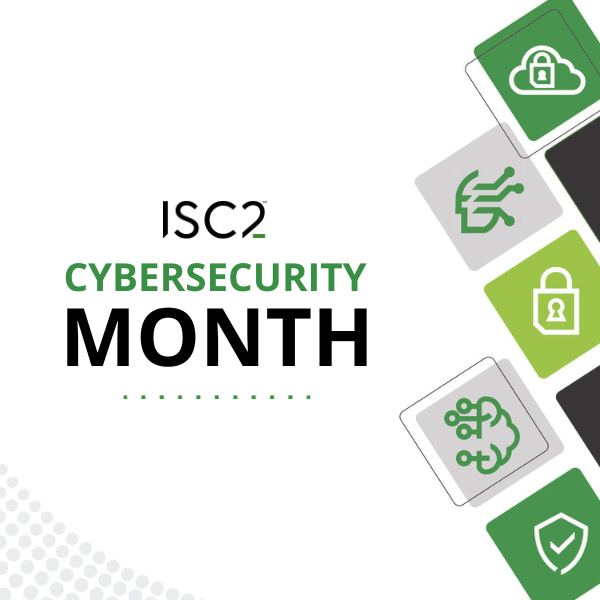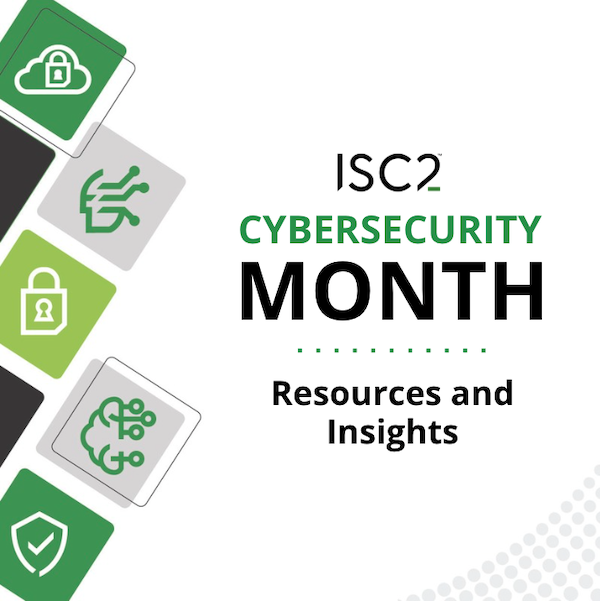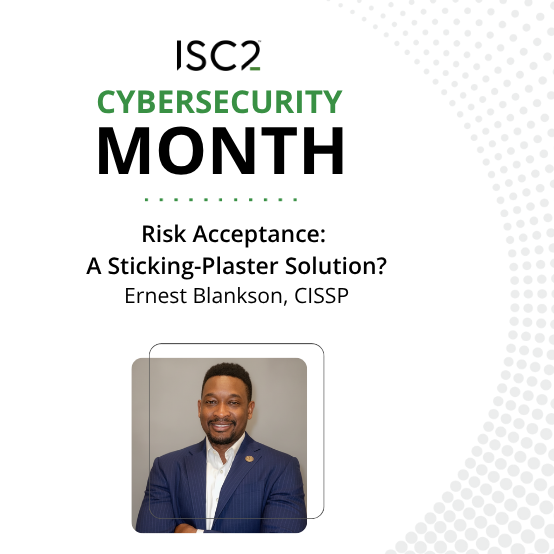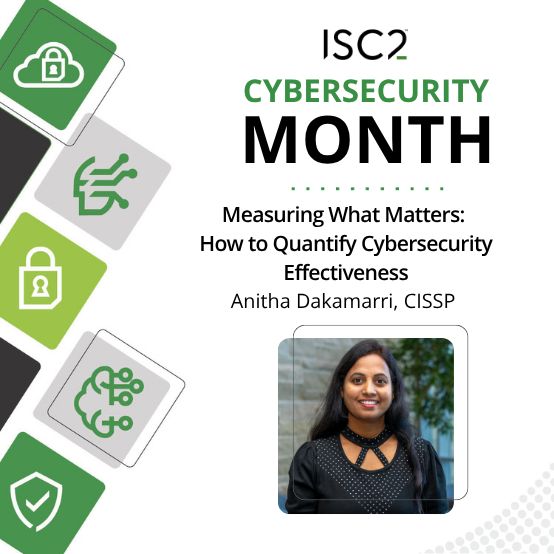Cybersecurity success isn’t just about stopping attacks. It’s also about being able to measure how well we are doing it – which is where information security metrics and key performance indicators (KPIs) come in. For Anitha Dakamarri, CISSP, these are not just numbers, they are the story of an organization’s security posture; a way to see, in real time, how effectively we prevent, detect and respond to threats.
 Disclaimer: The views and opinions expressed in this article belong solely to the author and do not necessarily reflect those of ISC2.
Disclaimer: The views and opinions expressed in this article belong solely to the author and do not necessarily reflect those of ISC2.
Security metrics aren’t limited simply to incident response times; metrics must include all the ‘sub-team’ efforts of a cybersecurity team. There are many types of cybersecurity metrics that can provide concrete data to justify security investments. Examples include (but are not limited to) coverage metrics, threat and vulnerability metrics, operational metrics, compliance and governance metrics, risk-based metrics, board/executive leadership metrics… and so on. Here are the metrics that are making a difference in my organization.
Coverage Metrics
When I started to be asked by leadership and other stakeholders, “Are we covering everything that matters?” was when I learned the power of coverage metrics. These metrics are like a security health map, measuring how complete our controls, monitoring and testing are across the environment. They help us to assess if all our important assets are, in fact, being watched, patched and tested – or whether there are hidden gaps waiting to be exploited.
Some coverage metrics quickly became part of our regular reporting. Asset coverage, for example, showed what percentage of servers, endpoints, code repositories and applications were inventoried and under active security management. It was eye opening to realize that even a few unmonitored systems could represent a significant risk.
Vulnerability scan coverage tracked whether those assets were regularly scanned, ensuring that we weren’t just aware of them, but actively looking for weaknesses. Patch coverage became another critical metric in our environment for measuring the percentage of critical vulnerabilities patched across all systems.
By tracking the percentage of critical assets sending logs to our SIEM, we could see exactly where our visibility was strong and where it was weak. Similarly, identity and access coverage highlighted whether users and applications had multi-factor authentication enabled and whether privileged accounts were being closely monitored. Finally, test coverage through penetration tests gave us confidence that our defenses would hold up under real-world attacks.
Looking back, these coverage metrics didn’t just help us measure our environment; they changed the way we thought about security. They made visible the gaps, guided our priorities and gave leadership a concrete way to see the scope and effectiveness of our program.
Threat and Vulnerability Metrics
After coverage metrics made a significant impact on how we considered metrics, we started to ask ourselves in our weekly meetings: “How do we measure if we’re truly getting better at defending ourselves or just getting lucky?” This was when I began to appreciate the importance of threat and vulnerability metrics. These metrics show us not only the number of attacks detected but also paint a picture of who and what the attackers were targeting.
We started tracking things like the total number of threats identified over time, the blocked threat rate and even which assets were the top targets. Seeing these threat trends overtime gave us a sense of rhythm. It helped us anticipate and prepare for the next wave. But identifying the threats was only half the story. The other side was about the cracks in our own armor - meaning our own vulnerabilities.
Vulnerability metrics became our mirror: reflecting where we were exposed and how quickly we were closing those gaps. We started measuring the total vulnerabilities discovered across our systems, tracking the percentage patched within service level windows and watching our average time to fix. There was even a moment of truth each month when we checked whether the number of vulnerabilities was going up or down.
At first, it was a bit overwhelming. Our backlog of unpatched vulnerabilities was higher than we thought or liked. However, having those numbers gave us clarity: instead of vague concerns, we had concrete data to prioritize defenses, allocate resources and hold ourselves accountable. In the end, threat and vulnerability metrics taught us something vital: that you can’t improve what you don’t measure.
Compliance and Governance Metrics
As I educated myself on metrics, I quickly learned that protecting systems and data isn’t just about stopping attacks. It’s also about ensuring that everything we do aligns with laws, regulations and internal standards. For our CISO, compliance and governance metrics are the lenses through which he can see the health of our entire security program.
During one audit, our team was measured on systems compliance – that is, the proportion of IT systems that adhered to frameworks like NIST, ISO 27001, SOC2, etc. Seeing those numbers highlighted to me that compliance isn’t just abstract but is tangible evidence that our systems meet industry standards. Each percentage point reflected real work done patching servers, configuring controls and documenting procedures.
Other Metrics
We also developed and measured metrics like audit findings open versus closed and policy breaches. Tracking regulatory training completion was eye-opening for us because, without employees understanding mandatory compliance or security awareness training, all our policies could be undermined.
Governance metrics added another layer of insight. Monitoring exception trends over time – ensuring that critical areas like access control, incident response and data protection were covered by documented policies – helped me sleep better at night. I knew that our security program wasn’t just reactive, it was structured, measured and accountable.
Metrics Tell a Story
When I first started working with security metrics, I thought the hardest part would be collecting the data. But the real challenge was learning to make the numbers meaningful. Over time, I realized that all these metrics weren’t just numbers to report. They tell a story about an organization’s integrity, the team’s diligence and our ability to protect what matters most. For our CISO, they are the compass that ensures security efforts are aligned with both legal requirements and business expectations.
Being the lead security engineer on that cybersecurity team, I realized that one of our most important responsibilities was to tell the story of security in a way leadership could understand. Executives and board members don’t just want raw numbers; they want to know the level of risk, how incidents affect the business and whether security investments are paying off. For example, reporting on vulnerability CVSS scores made sense to our engineers, but it didn’t resonate with the board. What they wanted to know was: “Are we safer today than we were last quarter, and are we spending wisely to reduce risks that matter most?”
My Advice for Others
Security metrics and KPIs aren’t just about charts or dashboards anymore. They are about translating highly technical activities into outcomes the business can understand and act on. The most effective KPIs are those that balance technical accuracy with business relevance. Instead of chasing numbers, your KPIs should tell the story of real risk reduction, smarter resource allocation and stronger decision-making.
I’ve come up with this checklist that might be helpful for other organizations to follow to make their metrics more valuable and useful:
- Define Clear Objectives – Metrics should support strategic goals, such as risk reduction, regulatory compliance, or improved incident response
- Tie Metrics to Business Impact – Ensure that each KPI reflects outcomes that matter to the business, not just technical activity
- Use a Layered Approach – Combine operational, threat, compliance, and business-impact metrics to get a holistic view
- Benchmark – Use external scorecards and peer data to contextualize performance
- Regularly Review and Update Metrics – The threat landscape and business priorities evolve; your metrics must adapt accordingly
- Visualize Metrics for Stakeholders – Use dashboards, heatmaps, and executive summaries to communicate insights effectively
Measuring cybersecurity effectiveness helps create confidence. Done correctly, metrics show leadership where we are strong, where we need to improve and how every investment contributes to a safer, more resilient organization. Metrics can turn your raw data into insight – and insight into action that makes everyone safer.
Anitha Dakamarri, CISSP, has 17 years’ experience in areas including threat modeling, application security, network security and risk assessments. She has held technical and management roles, with responsibility for penetration testing, security assessments, vulnerability management and building teams and processes.



